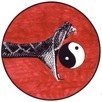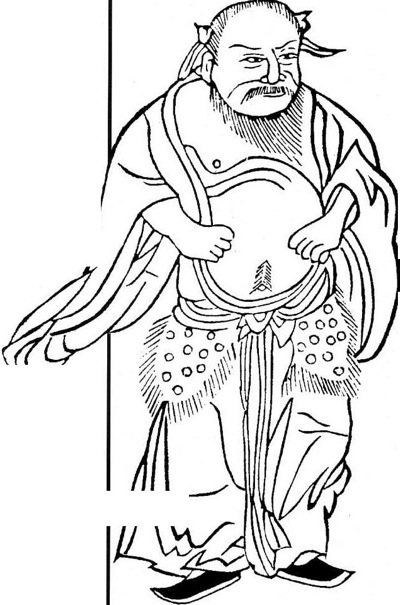
MONSTERMARTIALARTS.COM
The Source of the True Art!
MAKING KARATE AN INTERNAL ART
HOW TO ENHANCE YOUR PERFORMANCE BY APPLYING
INTERNAL PRINCIPLES TO ‘HARD’ STYLES.’

The truth of the matter is that Karate, if done correctly, can be as ‘internal’ as Tai Chi or Pa Kua (god Karate, in many respects, actually resembles Hsing I!) and while strength is important, it isn’t nearly important as porper technique. Following are a sampling of concept one should understand and incorporate in the Art so as to make it more internal. Follow them and you may be shocked at how quick and powerful your Karate will become in a very short period of time.
BODY TESTING
Body testing is the principle of having somebody push on your body so as to ascertain whether the structure is strong and sturdy, and able to withstand incoming Forces, or to sufficiently project outgoing Forces.
Body Testing will ensure that the arms are in the right positions so that the Tan Tien can flow energy through them.
Body Testing will also enable one to make sure that their stances actually work. Additionally, Body Testing will force the body to generate increased amount of energy.
This last concept, of increasing energy, is very important, and not to be confused with increasing muscle mass. The true test of whether your Body Testing is being done correctly is whether you can wiggle your fingers easily while somebody is pushing on you. If you can stay relaxed while handling incoming forces you are Body Testing correctly, and you are using energy internally.

Karate means ‘empty hand.’ Unfortunately, many people think Karate is how much you can fill your body with energy. The truth of the matter is that, in Karate, power is dependent upon space. While we could fill volumes with the import of this concept, let me just look at the physics of body impact to illustrate a little of it.
In the beginning of one’s study of Karate one is taught how to tighten the body upon impact. But as one progresses the body should be less tight, and only on a line between the fist and the ground. In fact, as a student matures he can even reach the point where he doesn’t tighten the body, or even the fist for that matter. While this may sound a bit bizarre, it is actually good physics. Consider what you are trying to do in Karate. You are trying to introduce weight sufficient to overload another person’s structure. Some people become enamored with power, what they need to achieve is not a massive explosive sensation within their body, but the concept of ‘giving weight’ to another structure. Consider the following analogy to help explain this concept of falling into somebody as fast as you can.
That is good Karate, and it doesn’t take any excessive amount of energy to make this happen. Interestingly enough, energy actually takes place at the launching of the technique, not at the landing of the body. Think about it.

CBM is ‘Coordinated Body Motion,’ and is a little concept I coined to better explain such things as ‘Using the body as oner unit,’ or ‘using the whole body.’
Before I explain this one, I should tell you that this concept pervades the martial arts. I have seen it written countless times and ways, and yet it is extremely misunderstood. Consider the following example:
‘Align the hands and the feet, the elbows and the knees, the hips and the shoulders.’
While this sounds good, it doesn’t explain fully what is needed. Consider my ‘official’ definition for CBM:
‘All parts of the body support one intention.’
This says it, but the actuality of realizing this concept depends upon taking into account the potential and mass of each body part (including such things as breathing, sinking the weight, body alignment, and so on) and integrating with every other body part to create a ‘whole body’ that supports one intention.
The key to CBM, and Karate, and the entire practice of the martial arts, is the concept of defining intention. Practicing CBM in your martial art not only supports, and therefore defines intention, and also unleashes it. When a human being finally defines his/her own intention his/her powers are virtually immeasurable.
CHANGING YOUR MIND
The key to becoming internal in your study of Karate is being able to ‘change your mind.’ This does not mean that you must continually vacillate. It means that you must continually seek to grow beyond your present knowledge with a totally open mind, or the famous ‘empty cup.’ You must understand that there are ways to use your body that are different than you might have been taught, or become used to. To aid in that process try some of the following concepts:
1) Your arm is a stick, the body is a watermelon. Don’t think of hitting somebody who is massive, but of sticking a stick through a watermelon. Master this concept and you have the actuality of what it is like to hit somebody, but without any of the prior misconception you may have become accustomed to over the years.
2) Have somebody say ‘Aaah,’ like when a doctor is examining the throat with a tongue depressor, and knock on his chest. Listen to the warble you create in his voice. Try to create the most warble with the least amount of force. It doesn’t take much if you consider you opponent’s chest as just a box of air.
3) If you have a strong stomach, get a raw steak and tear it apart with your bare hands. Consider the difference between that steak and your opponent’s body.
As you can see by the above examples there is vastly more to Karate than endless punching and blocking. Understand these concepts and you will understand what people who have been punching an blocking for ten or twenty years know. The martial arts are more based in concepts and philosophies than any beginner could ever imagine, and any barrier anyone perceives is dependent exclusively upon preconceptions.
In conclusion, let me say that the concepts I have outlined in this article are only the top of the iceberg, and that these concepts, and more, have been extant in the martial arts since the beginning. While I learned of them through my studies of Karate, I was quite surprised to find them sprinkled throughout books on other Arts. Unfortunately, most people are not ready for these concepts because they are not prepared to understand the written word, or because they have become so enamored (addicted) to the explosions of power in the body available through most Karate schools.
However, if you are going to get anywhere in true Karate, if you are going to ‘internalize’ your Art, and develop concepts beyond what is expected of today’s Karateka, and commensurate with those of other arts, you must learn to delve into physics, philosophies, and various other studies.
